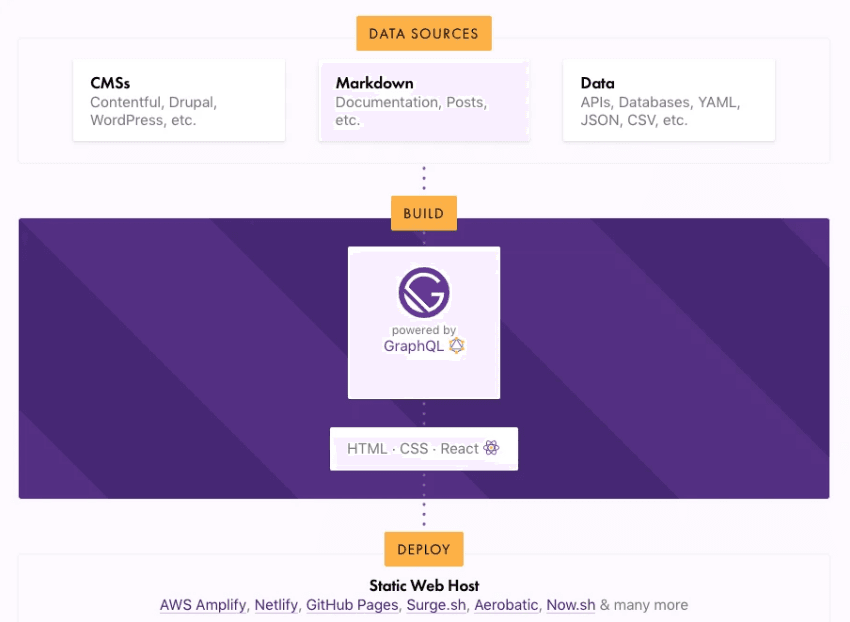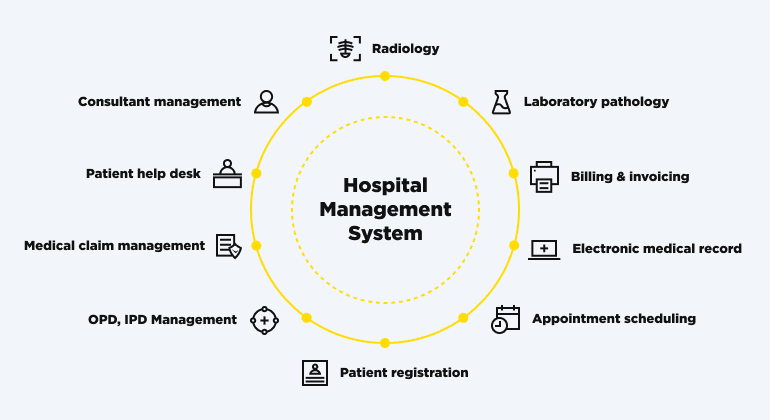Gatsby.js is not just a Static Site Generator (SSG). This is an ambitious project whose creators are aiming at WordPress' share of the CMS market. There is quite a lot of hype around Gatsby nowadays, and I decided that it is high time to write about this popular topic.
So if you ever wondered why everyone talks about Gatsby.js, what is it, and why it is so praised among web developers, then you are at the right place.
What is Gatsby.js?
Gatsby.js is a framework written in React.js. It is a SSG that you can use to create complete web applications. Probably the main feature of Gatsby is its high page loading speed. This attracts both developers and ordinary users.
That is how the process of building and deploying a static website with Gatsby.js looks like:

Why Gatsby.js If There Are Other Generators?
You might wonder why do you need another generator if you have Jekyll, Hugo, and other good tools? First of all, before Gatsby, there was no site generator based on React.js. For this reason, Gatsby is now popular in the React community and is actively used by its front-end developers.
Secondly, Gatsby builds complete applications. All sites built with Gatsby support Progressive Web Application (PWA) functionality out of the box. That is, the site owner does not need to do anything — his/her resource is already a progressive web application with all the advantages of this technology. Gatsby also supports efficient page and image loading and other features that improve site performance.
Plus, the websites built with Gatsby are the fastest.
Why is Gatsby.js So Fast?
Gatsby stands out for its extremely fast page loading speed. The framework uses preloading: when the user opens the main page, the browser in the background loads the data necessary to render other pages on the site that are linked from the main page.
Gatsby site is a React app, so only the page differences are loaded, not the entire page. During a transition, the virtual DOM is updated, and a user enjoys the highest loading speed ever witnessed.
Moreover, high speed is available right out of the box, which means that developers do not need to do extra work to somehow speed up sites. This also means that you don’t have to hire specialists in setting up a superfast website.
So as to compare, this is how it was before: a blogger or an owner of an online store installs a website on CMS for hosting. Then, after this blog or store starts becoming more and more popular, the speed of loading pages on the site slows down, SEO and sales positions fall, and you have to hire specialists that can solve these issues.
Usually, they adopted the following procedures:
Optimization of queries in the database by speed
Buying or configuring powerful servers to process a large number of database requests and web applications
Configuring Gigabit ports between servers
Playing around with Nginx parameters, configuring caching, and Content Delivery Network (CDN) connections for individual resources.
And after all these actions, you start understanding that with the growth of the resource, you need to abandon CMS and switch to some kind of custom development if you want fast loading or even just stay in business.
Fortunately enough, Gatsby.js has changed everything. This framework builds the project into files that can be hosted and accessed on any file hosting, and the site loading speed will be lightning fast.
Benefits of Gatsby.js
Let’s see what Gatsby.js offers other than its super speed. There are actually a lot of things that make this technology one of the leaders in modern web development.
Huge Security Gains
Sites on Gatsby.js are more secure because they do not use traditional web servers. All content is compiled at the stage of project assembly, and therefore there is no need to worry about unauthorized access to the database, web application, and hosting provider's console.
No Servers and No Databases
Placing a site with a standard architecture (web application based on PHP or CMS + Database) on hosting is costly and time-consuming. Additionally, there is always a risk of refusal if the content goes viral, causing a lot of traffic and a large number of requests.
When hosting a website with a standard architecture, you usually need to go to the hosting management console, create a database, users, decide whether the database will be accessible from the outside or locally. In my experience, such a database usually copes with a small number of connections (50 by default) and naturally has a speed limit depending on the hosting.
Gatsby completely solves this issue with the serverless architecture. Such a website never crashes from surges.
PWA by Default
Gatsby supports PWAs out of the box. That is, the site created with Gatsby is by default a progressive web application.
PWAs are primarily interesting because of the offline mode. That is, sites that support PWA functionality work even without an Internet connection. This can be important for projects with a mobile (traveling) audience. For example, PWA allows travelers on airplanes to access content offline.
Besides, PWA can be installed on mobile devices, like smartphones and tablets. This increases audience engagement and thus provides additional benefits to site owners.
Open Source with a Paid Team
Not only Gatsby.js is an open-source framework, but it also has a large team of seasoned developers and a solid community. Thus, it has great potential to grow thanks to constant contributions and team support, and everything will always be free of charge.
Plugin for All Tastes
Gatsy.js has a rich plugin ecosystem that enhances this tool even more to create the best developer experience for everyone. Whatever you might need when using the frameworks, there is like a plugin for it, so just go check it right on their official website.
Great Documentation
When starting working with a new tool it is very important to ensure that there is decent documentation that will support you on your way, and Gatsby.js has one of the best documentation I have ever seen. Their team really did a good job writing it.
Bring Your Own Content
The use of new frameworks in existing projects is usually limited due to the fact that you have to create a project from scratch. With Gatsby.js, this is not entirely true. Gatsby works great with existing CMS, including WordPress, Contentful, Drupal, Shopify, and so on. In addition, the sources for the site can be markdown files, CSV.
There is also support for Restful API, GraphQL.
Content Management
Gatsby.js works great together with headless cms. It allows to easily create and manage content, while everything is delivered via GraphQL (a request language for the API).
Modern Technologies
This framework is built on the JAMStack architecture, is a Static Site Generator, and includes a stack of modern technologies, such as React, Webpack, GraphQL, and modern JavaScript.
If you want to create a regular blog with Gatsby.js, there is no need for conducting a serious development since you can just use already made templates. For more complex projects, it has React.js, which is one of the best web development tools as of 2020.
Some Gatsby.js Examples
Gatsby.js team values deeds rather than words and proudly depicts examples of websites that were built using their framework. You can always review them on their official site and even submit your own one to their collection.
At the time of this writing, there are already Gatsby.js 979 websites depicted on their page.

The Future of Gatsby.js
As of 2020, Gatsby.js is a powerful development tool that offers an exciting development experience, but it misses usability for common users. Nevertheless, it seems that the company's development team is trying to get its product closer to ordinary users.
Their first step is to make Gatsby.js comfortable for content managers. It is important to create tools that a user without a programming background can use to publish and manage content. The team is steadily heading towards this outcome and released Gatsby Preview. It allows you to see changes on the site when the content manager is editing publications in the CMS.
Their second step implies greater accessibility for the average user. The Gatsby team wants a user to be able to create a website on Gatsby without technical knowledge, just like WordPress does. WordPress is both simple and functional. One does not need any special knowledge and superpowers to work with it. At the same time, it is a universal engine on which you can do everything from a personal blog to a corporate website or an online store.
In this manner, Gatsby.js might soon become one of WordPress’s major competitors, and that is one of the directions that Gatsby.js is heading for.
Final Words
Now you should know why Gatsby.js made a lot of noise. It is really a breath of fresh air for modern web development, and its features and benefits speak for themselves.
Make sure to check our Gatsby.js development services and feel free to contact our team if you’re looking for professional Gatsby.js developers to set up a new project.




